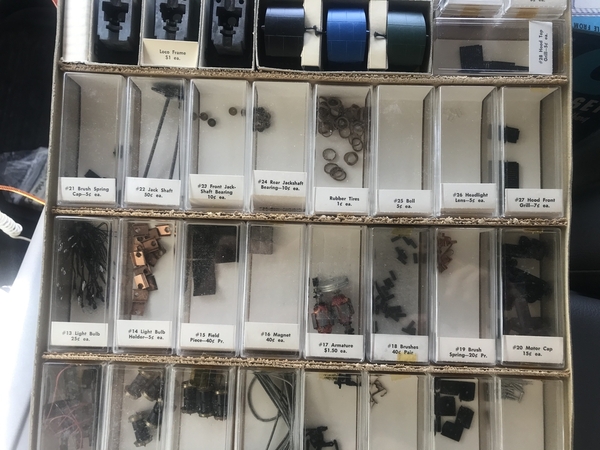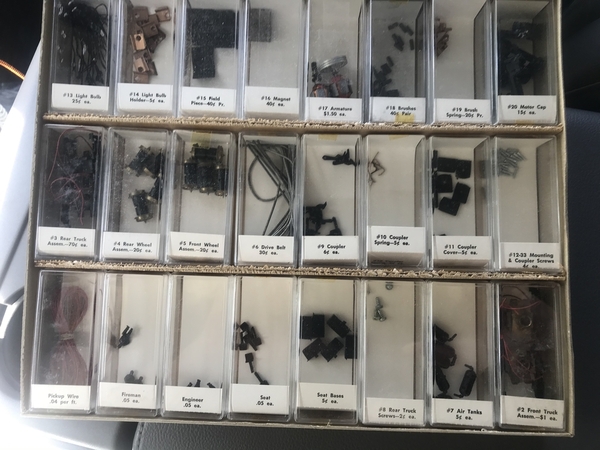Bob:
As long as it's quickly accessible when you have the time once home. Thanks.
Your latest set: Wow... for the mid-50s HO, that is a nice looking FM switcher!
Andre
|




|
Post your non-O scale stuff here!
Bob:
As long as it's quickly accessible when you have the time once home. Thanks.
Your latest set: Wow... for the mid-50s HO, that is a nice looking FM switcher!
Andre
Bob: That’s a neat little set. I’ve known of that little Fairbanks- Morse locomotive but doubt I’ve ever seen one. That’s a rare item.
Polks had their own line of HO?
I know back in the day in NYC they had a floor dedicated to model trains.
I was into racing cars upstairs on their track.
What HO did they produce? Any pictures of items or artwork?
Here are some of my “loosies”...
Tyco bobber collection (still missing a lot of them )
Bad picture of a really nice MIB Varney switcher
More loose red box TYCO stuff in a display case .
Now that’s a TYCO collection. Do you collect Mantua too?
@Varneynut posted:Do you collect Mantua too?
Not as a rule unless you consider these later Mantua kits ...these were purchased just yesterday at Don Carvers train shop in Gettysburg.
I have very little pre 1955 Mantua...just some early kits .
Like most of us (I suppose), my introduction to scale model trains was in HO scale: I gave that up a long time ago, but still pick up a few odds and ends as the opportunity or mood strikes. Here are a few of my "vintage" HO items.
First is a Mantua Pacific, along with the paperwork and what's left of the poor box:
This model has the enclosed gearbox and runs really well; instructions are dated "5/52".
Here are a couple of newer versions, with direct gearing; plastic cab, pilot and tender body:
The older kit is dated "12/67": the newer is "12/71"...
I have some other stuff I can show, but I'll have to dig it out.
Mark in Oregon
Mantua’s earlier diecast Mikado and Pacific’s had the enclosed gear called power drive. They really did run nice and Mantua even brought it back later for higher priced locos. Early versions had swinging bell on top front of smoke box, metal pilot and cab and the tender was eight wheel with no coal load. All came as kits in the early days with no paint. Nice items to have in a earlier HO collection.
The TYCO car I liked the best was the Derrick car which as far at I know was never a Mantua item. I have three different roads but they are hard to find and usually broken.
@Varneynut posted:I’ve read that HO started in Europe way back in the 1920’s but I’ve never even seen pictures of any of it.
The first HO set has been often credited to the European tin-plate manufacturer Bing. In 1922 they introduced the "Table Top" railway where the track gauge was 4mm. However, it was later classified as OO Here is a link: https://www.brightontoymuseum....y:Bing_Table_Railway
Technology improved and later 3.5 mm to foot was established as the official HO standard.
In the United States, George Stock was one of the first to produce HO scale starting in 1930 and he produced kits of mainly PRR prototype locomotives until the early 50's. These are extremely rare to find. As shown in one on my previous posts I have been lucky to find 3 of his GG1s over a period of about 12 years and I know of at least 6 in existence. The steam locomotives are hard to identify.
Thanks so much Jonathan, for the history and the link to the museum. I’ve been googling for quite a while and not finding much. It’s nice to know the early history and how it all started. Martin
Atlantis Model company of NY announced they have bought a large lot of tooling (molds) that includes Varney and Adams, both of which did HO plastic kits. No details but might be interesting.

 And here is a Varney lead boiler (not die cast) 0-8-0 heavy switcher and rare Varney wood and paper slope back tender. This locomotive kit came as a 2-8-0 Consolidated but one could use a Varney step pilot, not use the pilot truck, and build the special tender. This one was modified by the original builder by removing original sand dome and replacing with two after market domes. Note the front one is missing but I have found another. The prewar version of this boiler is cast brass, not lead and being a Reading RR locomotive had the flared out wide Wooten firebox for burning anthracite coal. Varney learned most modelers around the country did not like that firebox so post war was changed to vertical side version. This one runs very good and will pull anything.
And here is a Varney lead boiler (not die cast) 0-8-0 heavy switcher and rare Varney wood and paper slope back tender. This locomotive kit came as a 2-8-0 Consolidated but one could use a Varney step pilot, not use the pilot truck, and build the special tender. This one was modified by the original builder by removing original sand dome and replacing with two after market domes. Note the front one is missing but I have found another. The prewar version of this boiler is cast brass, not lead and being a Reading RR locomotive had the flared out wide Wooten firebox for burning anthracite coal. Varney learned most modelers around the country did not like that firebox so post war was changed to vertical side version. This one runs very good and will pull anything.
Andre ...your probably gonna hate me but do you remember the Lindberg service station dealer floor plan I told you about 5 or 6 years ago ....the one for 200 dollars ? Well I found another one today and it’s perfectly mint ! and it was only 75.00 dollars...I guess I’m a Lindberg collector now.




I like HO's but I'm not a HO collector. Because I'm partial to GG1's, I did collect all the GG1's AHM came out with in the yellow and blue boxes w/papers, including the limited edition ones. Total in all is 12.
Wow Bob! You did GREAT!
Mad? Nope... but certainly in awe at the condition of that service center set!
I've seen one similar on eBay for something like $400... but never would I spend such on a set.
Did you find that on eBay? If so, shame on me for not checking for Lindberg stuff for a few days!
Andre
Access to this requires an OGR Forum Supporting Membership
